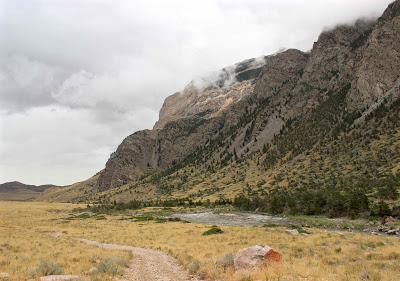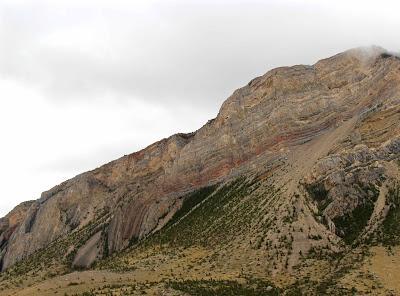
Clarks Fork Canyon and southeast Beartooth front; photo courtesy Tim Schoessler.
In northwest Wyoming, roughly 30 miles northwest of Powell, the Clarks Fork of the Yellowstone River leaves the Beartooth Mountains with great drama—by way of a canyon mouth so geologically spectacular that it’s included in field trips for everyone from high school teachers to professionals. Unfortunately, the rocks are a bit hard to explain. But the scenery’s great, even on cloudy days.

Looking downstream at south side of canyon mouth and basin beyond.

North side of canyon mouth.
Steeply-tilted Paleozoic sedimentary rocks rise abruptly from the lowlands, and are in contact with Precambrian rocks to the west. Between them is a 2-billion-year gap in the rock record, a Great Unconformity.
Arrow points to Great Unconformity between brownish Cambrian Flathead sandstone (500 million years old) and Archean metamorphic rocks (2.7 billion years) on north side of canyon. See the magpie? (lower right)
Most mountain ranges in Wyoming were uplifted roughly 70-40 million years ago during the Laramide orogeny, the event that created the Rocky Mountains. They have a distinctive style: broad blocks of crust shoved up along reverse faults over younger rocks.

Laramide-style uplift; from Regional Geomorphology, University of Wyoming, 1984.
This diagram shows a typical Laramide range. On the east, Precambrian (ancient) igneous and metamorphic rocks (brown) have been shoved up and over younger sedimentary rocks along high-angle reverse faults; Precambrian rocks make up the east flank and crest. On the opposite side, the rocks were folded rather than faulted, and there are outcrops of tilted sedimentary strata (in this case eroded to form hogbacks and strike valleys).At the canyon mouth, the Clarks Fork cuts through steeply-tilted sedimentary strata. Here the Beartooth front is steep and abrupt, and decorated with contorted sculpted rock.


Can you imagine rocks being folded like this?

In less than a quarter mile, the tilted strata start to flatten out.

Immediately west, the strata are nearly horizontal—note limestone bed on skyline. Further west sedimentary strata are gone, having been eroded off the crest of the range.
When I first saw the dramatic exposures of eroded sedimentary rocks on the Beartooth front, I presumed I was looking at a steeply-tilted, fault-free flank. Wrong. Here the Beartooth uplift was shoved east over younger rocks, via high-angle reverse faults (like the east side of the "typical" Laramide uplift above). So what’s with the sedimentary strata?

Cross-section through Beartooth front in vicinity of Clarks Fork Canyon (unlabeled diagram from Lageson & Spearing 1991, no source given).
The story is complicated and controversial. Popular geology guides wisely keep explanations short. In his great guide to geology east of Yellowstone Park, Bob Carson quickly passes by deformed sedimentary strata, and focuses on Precambrian rocks, the Great Unconformity and glacial features. In Roadside Geology of Wyoming, Lageson and Spearing include a cross-section showing the Beartooth reverse fault cutting through Precambrian and sedimentary rocks (basis for diagram above). Sedimentary strata are draped over faulted Precambrian rock. But discussion is brief: “Beds of Paleozoic limestone were folded over the edge of the Beartooth uplift, then eroded”
Precambrian metamorphic rocks dominate the Clarks Fork Canyon and Beartooth Plateau; view southwest from inside canyon mouth, at end of paved road.
I defer to experts for further discussion (see Sources below). Here’s some of what they’re thinking:In the “spectacular fold at the mouth of the canyon” sedimentary strata are draped over a faulted basement (Precambrian) block. This structure is slightly older than the Beartooth uplift and therefore was deformed by those faults (various authors; summarized in Heasler et al. 1996; PDF).
Laramide models used to incorporate vertical uplift. But with seismic and drill-hole data, it has fallen out of favor, replaced by uplift via high-angle reverse faults, accommodating crustal shortening. However in situations where faults are very steep (e.g. Beartooth fault at Clarks Fork Canyon), the vertical uplift model may be valid, and sedimentary strata may well be draped over faulted basement rock (Brown 1995).
O’Connell (1996) argued for multiple stages of faulting, and invoked zones of preexisting weakness in basement rocks. He argued against drape-folding.
The southeast Beartooth front is in a complex transition zone involving the western Bighorn Basin, with its own faults and Laramide history. Thus the front has been affected by multiple episodes of deformation (Neely 2006; PDF).

North side of canyon mouth (labeled based on Heasler et al. 1996).

Looking downstream at south side of canyon mouth; arrow points to rotated Bighorn dolomite (based Heasler et al. 1996, Wise 1983).

“We gather at the base of the crag to study the rocks. The instructor assigns them to type and age, and proclaims the cause of their deformation—all the while waving his arms in the air while we frantically write everything down in our field books. Later, we read that others think differently.” (anonymous geology student ca. 1985)
Sources (in addition to links in post)
Brown, WG. 1995. Structural style of Laramide basement-cored uplifts and associated folds in Snoke, AW, Steidtmann, JR, and Roberts, SM, eds. Geology of Wyoming. Wyoming State Geological Survey Memoir 5:312-371.Carson, RJ. 2010. East of Yellowstone; geology of Clark’s Fork Valley and the nearby Beartooth and Absaroka Mountains. Sandpoint, ID: Keokee Books.
Heasler, HP, Jaworowski, C, Jones, RW, De Bruin, RH, and Ver Ploeg, AJ. 1996. A self-guided geologic tour of the Chief Joseph Scenic Highway and surrounding area, northwestern Wyoming. Laramie, WY: Wyoming State Geological Survey Public Information Circular No. 35. PDF
Lageson, DR and Spearing, DR. 1991. Roadside geology of Wyoming, rev. 2nd ed. Missoula: Mountain Press Publishing.
Neely, TG. 2006. Three-dimensional strain at foreland arch transitions: structural modeling of the southern Beartooth arch transition zone, northwest Wyoming. MS thesis, Colorado State University, Fort Collins. PDFO’Connell, PJ. 1996. Kinematics of the eastern flank of the Beartooth Mountains, Montana and Wyoming, in Wyoming Geological Society 47th Annual field Conference Guidebook.
Wise, DU. 1983. Overprinting of Laramide structural gains in the Clarks Fork Canyon area and eastern Beartooth Mountains of Wyoming, in Wyoming Geological Society 34th Annual field Conference Guidebook.